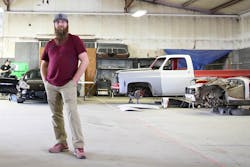SHOP STATS: Best Body Shop Location: Wichita, Kan. Operator: Clay Hoberecht Average Monthly Car Count: 45 Staff Size: 8 Shop Size: 6,000 square feet Annual Revenue: $1 million projected for 2017
Clay Hoberecht’s road to owning his own shop has been anything but easy. With each step came a new obstacle, but through passion and determination, Hoberecht went from someone who was “unhirable” to owning his own shop that’s grown its annual revenue from $70,000 to $1 million in the short span of three years.
Hoberecht’s background is different than most. He didn’t grow up in the industry and hasn’t always seen himself ending up there. When the time came to decide what to do with the rest of his life, Hoberecht decided to go after something that had always fascinated him: fixing cars.
After being turned away by what felt like every shop in Wichita, Kan., Hoberecht finally caught a break when he decided to start offering his work for free—while working at Walmart and practicing on his own vehicle on the side. Over the next 16 years, he had stints at a number of different shops and worked out of his home garage before he decided to officially open his own business, Best Body Shop, in 2014.
The building that Hoberecht found had no bathroom (actually, it had no running water at all) and four parking stalls. By providing quality repairs, Hoberecht was able to expand and purchase an accompanying property. Since opening three years ago, the shop has done some sort of expansion every eight months.
With a shop to call his own, Hoberecht was able to do the things he had always wanted to do in a shop, including building a team-based culture.
The way my day is scheduled has changed. I recently attended a 3M event in Detroit and when I came back, I realized that the staff knew how to operate without me there. I found out one of my guys really stepped up, so I’ve started grooming him into a manager and showing him what it takes to lead a team. That’s freed up time for me to do follow-up calls, interviews and social media.
Every morning, we have a one-hour team meeting that starts at 8. What we discuss is mostly personal issues. I think one of the biggest problems in our society is that people have accepted the fact that they’re not satisfied with their work. People are always saying, “I can’t wait until 5.” Why? What happens at 5? There’s no reason you can’t enjoy your work. That’s why I’m always checking in with my employees. Each day, I have them each write out three goals. It could be, “What are your professional goals for six months from now?” or, “What are your personal goals for the rest of the month?” Recently, I even had them make goals for each other.
Another way I check in with the team is to take each one of them out to a one-on-one lunch once per month. I focus on how they’re doing in their personal lives and I give them feedback professionally. Clarity is huge for me and getting out of the shop is a great way for me to let them know what’s going on. You have no idea what’s actually going on with your team unless you spend time with them. Something that really pisses me off is owners that say, “Leave your problems at the door.” What that says to me is that you want your employees to lie. Those personal problems will impact the way a door is repaired. I don’t want successful body people, I want successful people. If one of my employee’s wives was having surgery and he was at work just to prove he was a good employee, I wouldn’t be happy with that choice.
Every day, my wife, Barb, makes lunch for the entire crew and we all eat it together. On Monday, everyone chips in $20 and she goes shopping for ingredients and snacks to keep in the office. The guys look forward to lunch. We have a group text conversation between the employees and when Barb announces that lunch is ready, it becomes GIF central.
The way I assign duties and distribute raises in my shop is not traditional. I actually assign a numerical value to each of my employees. This system came out of necessity because, in the beginning, I felt like I was doing everything. Before I started my own shop, one thing I never understood or liked was the flag system. It seemed to me like this created a line between body and paint. When a job is flagged, everyone is trying to get the vehicle out of their stall as quickly as possible. I wanted to create a profit-sharing system where everyone was focused on the same thing: a car, ready to go, looking flawless and the shop making a profit.
Learn More About How Hoberecht's System Works:
—Hoberecht has created a list of 34 skills that someone at his shop needs to become the ultimate body technician. Upon being hired, Hoberecht asks the new employee to look at his list of levels and select the one that they think best matches their skill set before Hoberecht assesses them himself. If someone needs to be moved up or down, he lets them know and makes the adjustment.
The system starts with gatekeeper and moves up to level 10. Gatekeeper is the entry-level position and is where someone with no experience would start. In order to advance on levels 1-6, 200 percent efficiency in three skills on the list is required. For levels 7 and up, four skills are required. Each time a new level is achieved, the employee moves up a pay grade.
I broke down all of the tasks involved in a repair. Then, in ascending order of difficulty, I grouped three tasks together and assigned it a value. Once a staff member has mastered those three skills and can demonstrate them to me, they move up a level. There’s no time frame, and if they can do it, then they’re good. With each level they move up, they get a $1 raise. If someone comes to me and says they need a raise, I point to the board with all of the tasks that we have displayed in the shop. It’s all about transparency.
I mentioned that my typical daily schedule has changed. I’ve now broken my day down into five main tasks: sales, finances, shop development, team development and estimating. I spend two hours on each. Then, I help out with whatever else is needed in the shop. Honestly, I would say I work between 16–18 hours per day. This is by choice. I enjoy the extra time I spend at the shop finding ways to make it better. I discipline myself to spend 8–10 hours as the CEO and then I get to play with the cars.
Before the shop opened, my wife and I had a long discussion about what it would mean when the shop opened. I don’t believe in a work-life balance. What I mean by that is I don’t think the two have to be separate. Why can’t you bring your daughter into work? My daughter is three years old, and I’ll bring her in, and even if things are crazy, I’ll walk to the nearby gas station to get an ice cream with her. Since my wife works at the shop, we get to have fun together during the day and we set date nights. We make time for each other. There’s no reason you can’t integrate work and personal life.
After just opening my shop, a customer commented on what a great job we did on a repair of his. We got to talking a little bit on my vision for my business and he told me he was going to send me a book. He sent me The Five Dysfunctions of a Team. That book was a game changer for me. It showed me how to operate as a team and build a layer of trust.
After reading this book, I began doing research. I found two distinguishing factors of entrepreneurs: They read a crazy amount and they don’t smoke. Right then, I started reading more and quit smoking cold turkey. I buy Audible audiobooks for everyone on my team and we go through a book per month and meet about it. It’s so important for me that my team understands my thought process and it’s not just, “Do this and this and this,” and the team has no idea why. I’m all about transparency.
How Media Has Influenced Clay Hoberecht's Career
—
Clay Hoberecth's Picks
- The Five Dysfunctions of a Team by Patrick Lencioni
- The 10X Rule by Grant Cardone
- EntreLeadership: 20 Years of Practical Business Wisdom from the Trenches by Dave Ramsey

